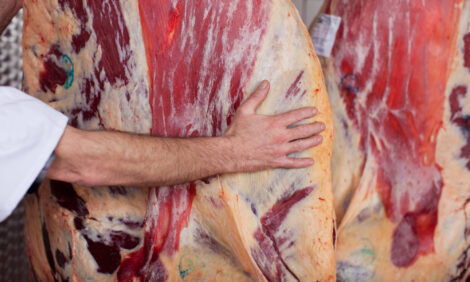



Breeding Dairy Heifers - When To Breed?
NORTHERN IRELAND, UK - It is well established that feeding and management of Holstein-Friesian heifers should be geared around achieving a live weight at first calving of 540-580 kg at 24 months of age.To achieve this target, feeding management must ensure that heifers reach target live weights for breeding at 13.5-15 months of age.
Monitoring heifer growth is key to making informed management decisions. A survey of heifer rearing practices undertaken by AFBI and the College of Agriculture, Food and Rural Enterprise (CAFRE) found that relatively few producers weighed heifers (less than 10 per cent). This work also highlighted the significant differences which can exist between producer estimates of live weight based on visual appearance and the actual live weight of heifers at different stages (Table 1). On average, producers underestimated the weight of heifers, particularly at the breeding stage.
In view of this, AFBI developed a calibrated weigh band to help producers monitor the progress of heifers against targets, facilitating a cost effective rearing regime. With over 21,000 animal recordings used to construct the prediction model and 850 recordings used for validation, the weigh band gives a robust and reliable indication of the weight of Holstein-Friesian heifers.
In the AFBI/CAFRE survey, the average age of heifers at first service was reported by producers to be 17.9 months.. However, there was a considerable range (12.5-30 months), with 59 per cent of producers estimating an average age at first service greater than 16 months (Figure 1). This resulted in an average age of heifers at first calving of 30.4 months.
Research over a number of years has indicated that, economically the optimum age at first calving is between 23 and 25 months of age. Analysis of industry data by AFBI has shown that, whilst first lactation yields are maximised by increasing age at first calving beyond 25 months of age, this is outweighed by the additional rearing costs and poorer reproductive performance which impacts on overall lifetime yield. Furthermore, work in GB has shown fewer problems around calving and increased herd life (+0.2 lactations) with heifers calving at 24 compared with 36 months of age.
Through artificial insemination (AI) more rapid genetic progress can be made using superior bulls to those generally kept as stock bulls. Industry reports note that almost 75 per cent of New Zealand dairy cows and 92 per cent of Dutch dairy cows are bred by AI.
In Northern Ireland the AFBI/CAFRE survey found that 62 per cent and 69 per cent of dairy producers use AI on greater than 50 per cent of heifers and greater than 50 per cent of cows, respectively. As would be expected when selecting sires for breeding heifers, ease of calving rated highly among farmers in the AFBI/CAFRE survey, with 88 per cent rating it as important or greater (Table 2).
Least important of the criteria listed was Profitable Lifetime index (PLI), with only 35 per cent of farmers having rated it as important or greater when selecting bulls. Selection indexes are the best way to combine information on the large number of traits now available for sires. These traits are weighted based on their economic importance and therefore provide an overall value for the total economic merit of a sire. Increased emphasis on PLI values when selecting bulls will help direct more balanced breeding in the industry.
Key messages relating to breeding age of heifers:
- Replacements on Northern Ireland dairy farms were found to be generally reared at growth rates which enable adequate weights to be reached for calving at 24 months of age.
- The commonplace delay in breeding heifers until >16 months of age was in part due to under prediction of heifer live weight.
- Monitoring heifer weight for age is the key to success.
- Use of a weighbridge or the AFBI weigh band provides confidence to serve heifers early at the optimum age and weight to ensure calving at 24 months of age at 540-580 kg.
- Increased emphasis on PLI as a selection criterion will improve the sustainability of the dairy industry.
Table 1. Live weights of heifers on Northern Ireland dairy farms (farmer estimate and actual) (AFBI/CAFRE heifer survey).
| Development stage | Target weight for age (kg) | Target weight for age (kg) | Actual live weight (kg) | Percentage difference (%) |
|---|---|---|---|---|
| Weaning | 92 | 85 | 96 | -7.1 |
| Breeding | 433 | 378 | 438 | -11.2 |
| Calving | 580* | 555 | 585 | -3.8 |
|
*Target weight for calving at 24 months of age but average age of heifers was 27 months with projected calving age of 29 months
|
||||
Table 2. Relative importance of factors considered by Northern Ireland producers for selecting sires to breed heifers (AFBI/CAFRE survey)
| Bull choice criterion | Percentage rated as important or greater |
|---|---|
| Ease of calving | 87.8 |
| Milk composition | 83.3 |
| Other | 64.0 |
| Milk yield | 75.7 |
| Type traits | 68.6 |
| Cost | 37.3 |
| PLI value | 34.8 |
TheCattleSite News Desk


